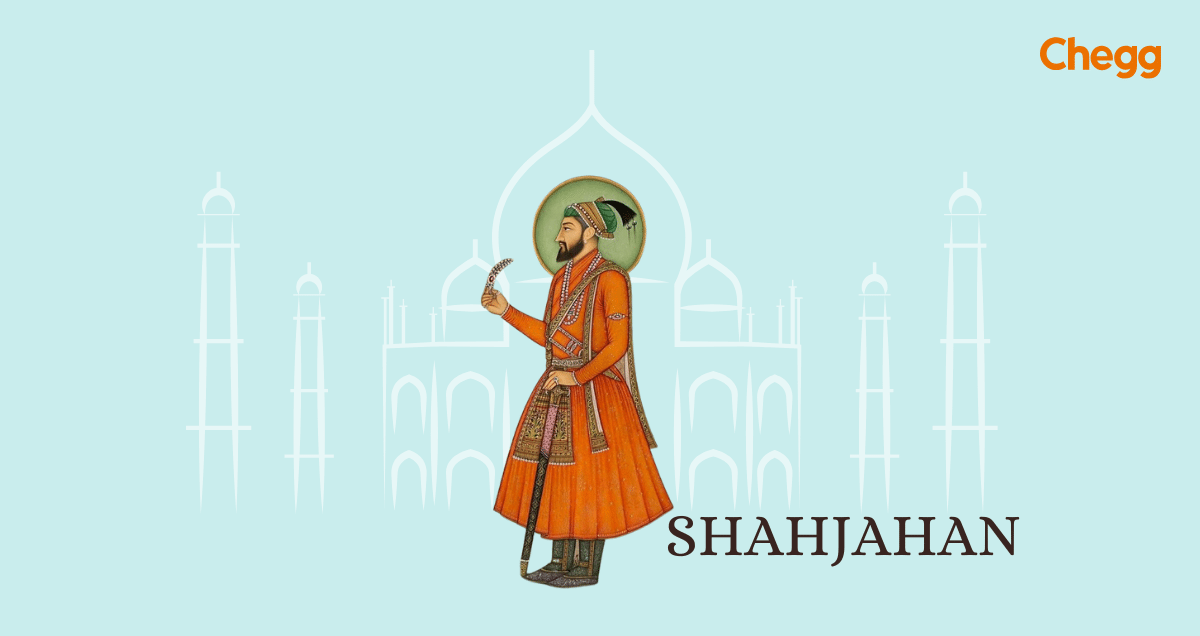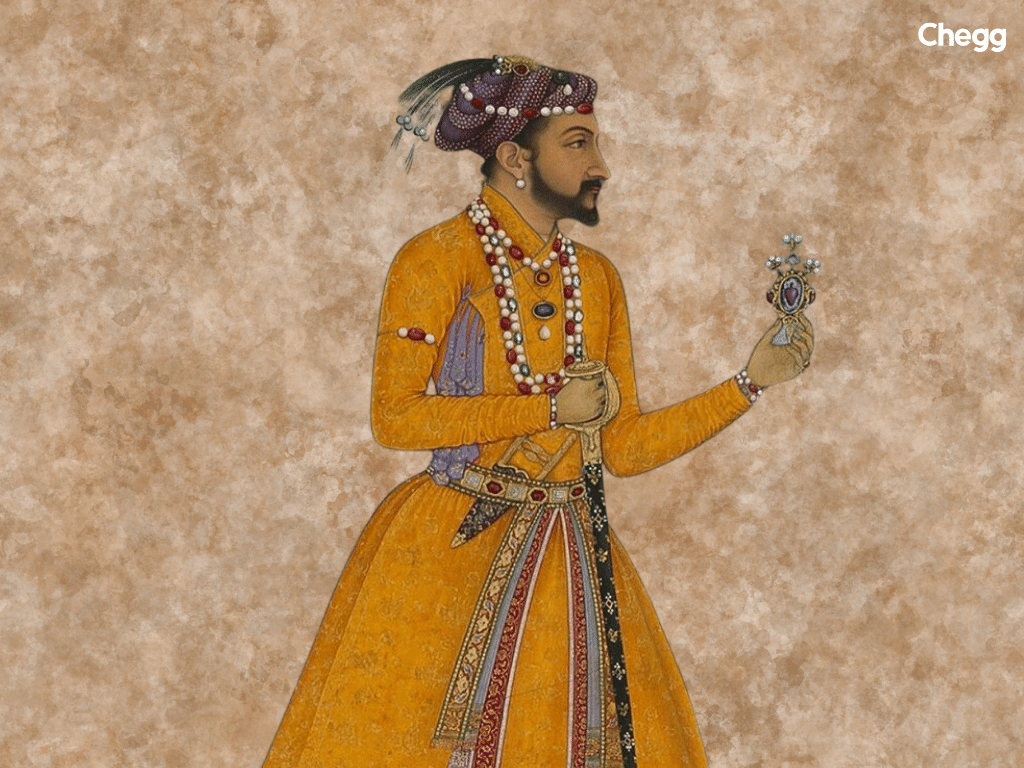

Quick Summary
He was an important Mughal emperor who ruled from 1628 to 1658. He’s famous for building the Taj Mahal in memory of his wife, Mumtaz Mahal. During his time, there were great advancements in art, literature, and how the kingdom was run. He made a big impact on India’s culture and history.
During his 30-year reign, the Mughal Empire reached its peak. The development and expansion of architecture and arts later earned this period the title of the golden period of the Mughal Empire. He also earned a reputation as a great and effective administrator.
Shah Jahan, a skilled military leader, showcased his capabilities early on by conquering Mewar and eliminating rivals, including his brother Shahryar, to secure his throne. Though Mughal succession typically favoured the eldest son, Shah Jahan’s governance of key regions like Bengal and Gujarat strengthened his claim. He bolstered the empire’s military might through rigorous training and armament production. On the personal front, he had multiple wives, with Mumtaz Mahal, his beloved, inspiring the iconic Taj Mahal after her tragic death in 1631. His later years were marred by illness and familial strife, particularly the power struggle involving his sons, including Aurangzeb, who would eventually lead to the empire’s decline.

| Attribute | Details |
|---|---|
| Reign | 1628 – 1658 |
| Full Name | Shahab-ud-din Muhammad Shah Jahan (also spelled Shah Jehan or Shahjehan) |
| Born | January 5, 1592 |
| Birthplace | Lahore (present-day Pakistan) |
| Died | January 22, 1666 (aged 74) |
| Place of Death | Agra (present-day India) |
| Buried | Taj Mahal, Agra |
| Predecessor | Jahangir |
| Successor | Aurangzeb |
| Wives | Akbarabadi Mahal, Kandahari Mahal, Mumtaz Mahal, Hasina Begum Sahiba, Muti Begum Sahiba, Qudsia Begum Sahiba, Fatehpuri Mahal, Sarhindi Begum Sahiba, Manbhavathi Baiji Lal Sahiba |
| Offspring | Jahanara Begum, Dara Shukoh, Shah Shuja, Roshanara Begum, Aurangzeb, Murad Baksh, Gauhara Begum, plus many who died in infancy |
| Dynasty | Mughal |
| Father | Jahangir |
| Mother | Princess Manmati |
| Religious Beliefs | Islam |
| Significant Monuments | Taj Mahal (Agra), Red Fort (Delhi), Jama Masjid (Delhi), Moti Masjid (Lahore) |
| Major Contributions | Extensive advancements in Mughal architecture |
| Notable Projects | Shalimar Gardens (Lahore), Portions of Lahore Fort, Jahangir’s Mausoleum |
| Cultural Impact | Promoted arts, culture, and architecture during his reign |
| Legacy | Renowned as one of the greatest patrons of Mughal architecture |
Shah Jahan was born in Lahore, Pakistan, to Prince Salim, who later became Emperor Jahangir, and his Rajput wife, Princess Jagat Gosaini from Marwar, also known by her Mughal name, Bilqis Makani. His grandfather was Mughal Emperor Akbar.
Originally named Prince Khurram, he later adopted the regnal name Shah Jahan. He was Jahangir’s third son and was considered the most capable and competent to rule. After Jahangir’s death, Shah Jahan successfully defeated his rivals for the throne and was crowned on 14 February 1628 in Agra.
He received education in martial arts and various fine arts, primarily under the care of Empress Ruqaiya Sultan Begum, Akbar’s first wife who had no children of her own.
| Relationship | Name | Description |
|---|---|---|
| Father | Emperor Jahangir | Fourth Mughal emperor |
| Mother | Nur Jahan | Influential Mughal empress |
| Grandfather | Emperor Akbar | Third Mughal emperor |
| Wife (Principal) | Mumtaz Mahal | The Sixth Mughal emperor, expanded the empire |
| Other Wives | Kandahari Begum, Izz-un-Nissa Begum | Additional wives |
| Children | Dara Shikoh, Shah Shuja, Aurangzeb, Murad Bakhsh, Jahanara Begum, Roshanara Begum | Notable children |
| Siblings | Parviz, Khusrau Mirza, Shahryar | Brothers |
| Notable Descendants | Emperor Aurangzeb | The Sixth Mughal emperor expanded the empire |

| Monuments Built by Shah Jahan |
|---|
| Taj Mahal (Agra) |
| Red Fort (Laal Qila) (Delhi) |
| Jama Masjid (Delhi) |
| Pearl Mosque (Moti Masjid) (Lahore) |
| Shalimar Gardens (Lahore) |
| Portions of the Lahore Fort (Lahore) |
| Jahangir’s Mausoleum |
| Takht-e-Taus |
| Shahjahan Mosque (Thatta) |
The reign of Shah Jahan (1628-1658) is often referred to as the “golden age” of the Mughal Empire for several reasons:
However, it’s important to consider a balanced perspective:
Shah Jahan’s reign was peaceful and stable. However, towards the end of it, some issues arose throughout the empire. he had proven his abilities with the military even when he was a prince. Because he had such control over the military, he could succeed to the throne even in favour of Nur Jahan.
Also Read:-
Discover Humayun: The History, Life, and Legacy
Rajendra Chola: A Simple Introduction to History
Delhi Sultanate: Exploring History, Facts, Maps, and Rulers
Shah Jahan’s reign is notable for his successes in battles across the country. His reign, though a splendid period in terms of architecture and expansion of the empire, later became the starting point of the destruction of the empire. Because of his relentless attempts to expand the empire to the Deccan plateau, the empire was on the verge of bankruptcy.
Shah Jahan is known as a contemporary of France’s King Louis XIV. He was passionate about architecture and building. The era is recognized as the magnificent period of the royal court, attracting artisans from around the world. It was also a period of great literacy, with calligraphy and painting being promoted.
Though born to a Hindu mother, Shah Jahan was Muslim. He was more orthodox Muslim than his father or grandfather. He was a tolerant ruler of the Hindus.
His reign is referred to be the “Golden Age of Mughals,” and he is regarded as one of the greatest Mughals. The most well-known of Shah Jahan’s numerous magnificent constructions is the Taj Mahal in Agra. The grand mosque and palace in Delhi, the Pearl Mosque in Agra.
Shah Jahan was married four times.
They termed Shah Jahan’s reign the Golden Age of the Mughal period due to the relative peace and stability prevailing in the country. There were no foreign invaders, and trade and commerce flourished in the country. Various travellers from across the world also came to visit the marvels that he had built.
Jahangir, Murad Mirza, and Daniyal Mirza are among the sons of Akbar the Great, the third Mughal emperor.
Got a question on this topic?
Chegg India does not ask for money to offer any opportunity with the company. We request you to be vigilant before sharing your personal and financial information with any third party. Beware of fraudulent activities claiming affiliation with our company and promising monetary rewards or benefits. Chegg India shall not be responsible for any losses resulting from such activities.
Chegg India does not ask for money to offer any opportunity with the company. We request you to be vigilant before sharing your personal and financial information with any third party. Beware of fraudulent activities claiming affiliation with our company and promising monetary rewards or benefits. Chegg India shall not be responsible for any losses resulting from such activities.